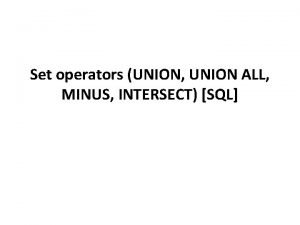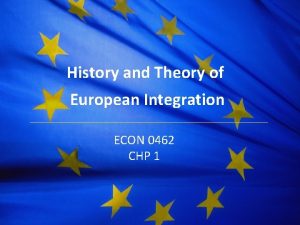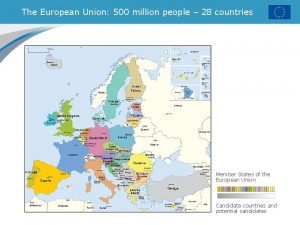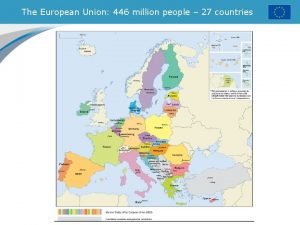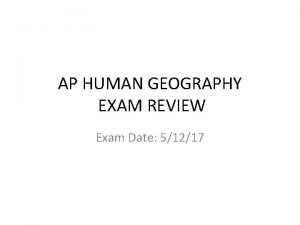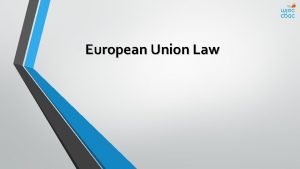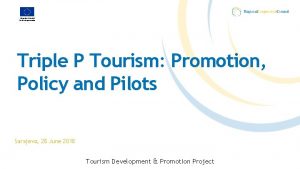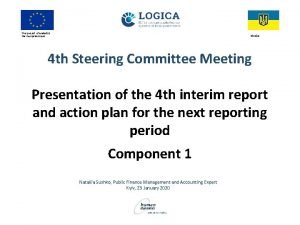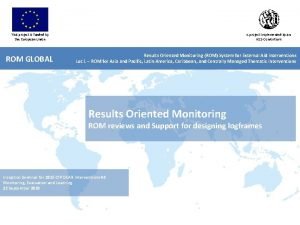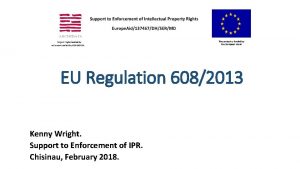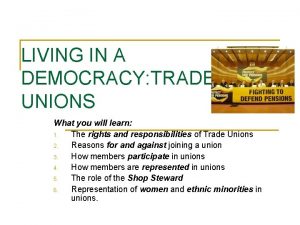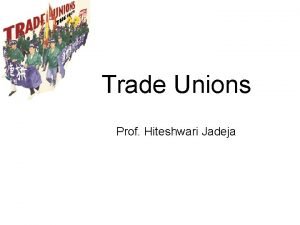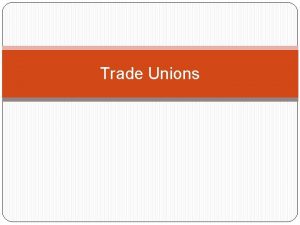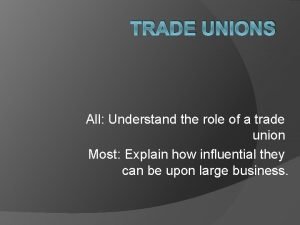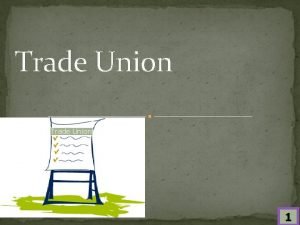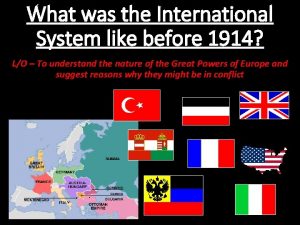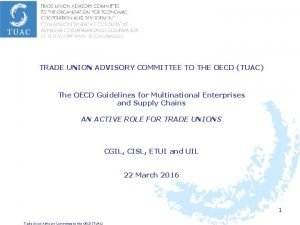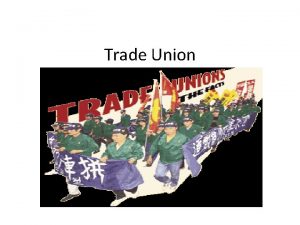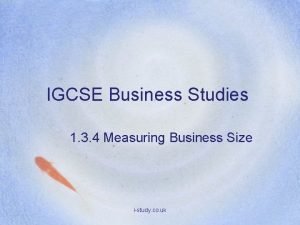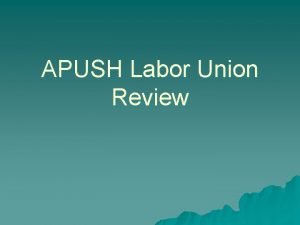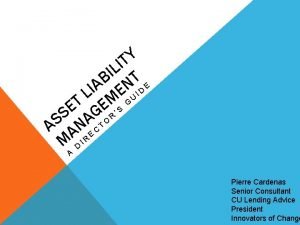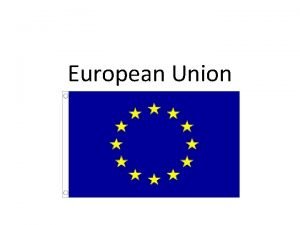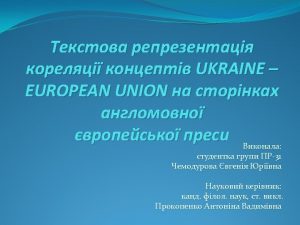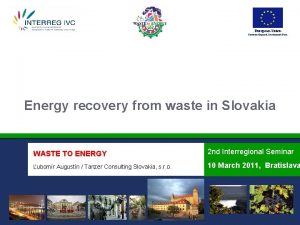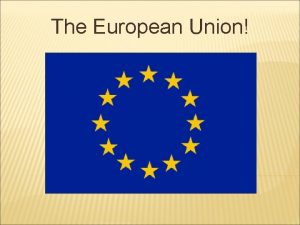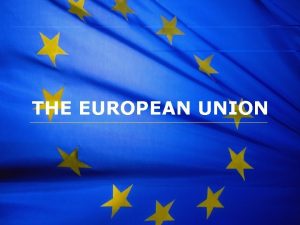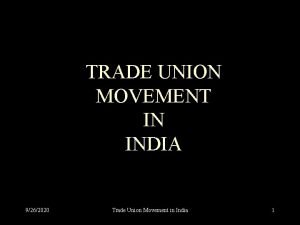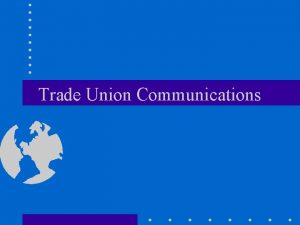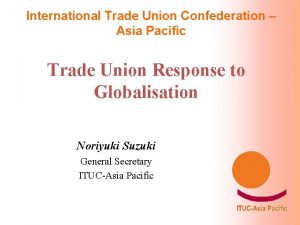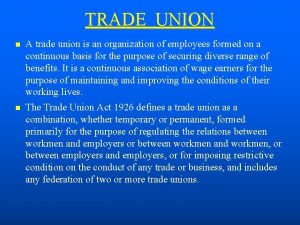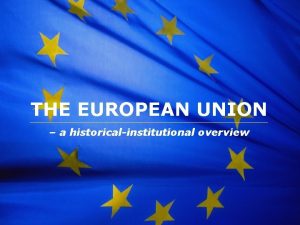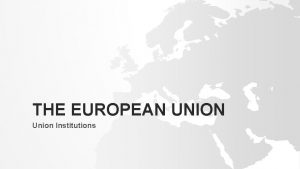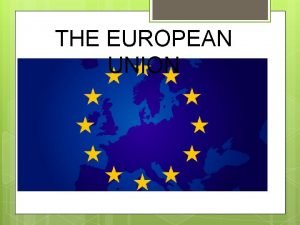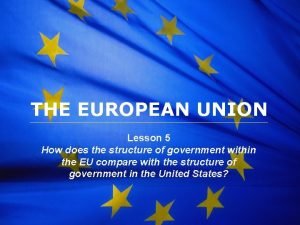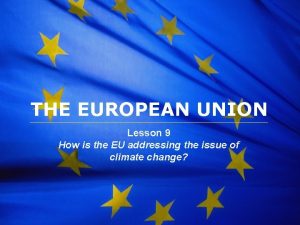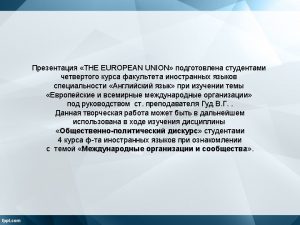Session 2 The European Union Trade Policy Jayendra




































- Slides: 36

Session 2 The European Union Trade Policy Jayendra Rimal 1

Day Two 4. EU Trade Policy - How it works 5. EU Trade Policy – Competing in the world 6. EU Trade Policy – WTO Context 7. Conclusion 2

4. EU Trade policy - How it works Historic development From tariffs and quotas. . . … to “behind the border” issues The new shape of trade policy Developed from trade liberalisation in goods… … to services and rules on investment, intellectual property, public procurement Evolution reflected in the Treaty of Nice (2001) Extended the EU trade competence to services and commercial aspects of intellectual property rights with qualified majority voting 3

4. EU Trade policy - How it works NOW The EC Treaty establishes the overall aims and objectives of EU trade policy: Article 2 sets the general aims – including to promote the development of economic activities, high employment and competitiveness, and environmental protection. Articles 131 and 133 explain the way the common commercial policy shall operate in principle – “to contribute, in the common interest, to the harmonious development of world trade, the progressive abolition of restrictions on international trade and the lowering of customs barriers”, instruments and scope. ” Article 133 sets out the scope, instruments and decision-making procedures. Article 300 establishes the current inter-institutional procedure for concluding international agreements – principally by the Council, not legally obliged to consult the European Parliament on trade agreements, 4 but consultations do, however, take place.

4. EU Trade policy - How it works NOW Article 133 of the EC Treaty provides in more detail for the common commercial policy Rests on: • Shared, uniform concept of policy • A decision-making process based on a mixture of ‘exclusive and shared competences’ Comprises: • Trade in goods, services and trade-related aspects of intellectual property rights • Special provisions for specific fields (e. g. audiovisual, cultural, educational, social and health services) 5

4. EU Trade policy - How it works NOW The negotiating process The Commission is the negotiator • On behalf of the 27 Member States The Council is the decision maker • Mandate = determined by the Council on the basis of a Commission proposal • The Commission negotiates on the basis of this mandate • The Council approves the result of the negotiation (generally by qualified majority) The European Parliament • Is informed by the Commission of trade policy developments • Gives “assent” on major treaty ratifications (covering more than 6 trade)

4. EU Trade policy - How it works How it could change … To extend the scope of trade policy to all foreign direct investment EP to be informed of negotiations like Member States PROPOSALS IN THE EU CONSTITUTION To increase parliamentary control: co-decision for all autonomous acts of legislative nature, assent for major trade agreements Further extension of qualified majority voting for trade agreements 7

4. EU Trade policy - How it works A comparison between the EU and the US Efficiency • Exclusive EU competence EU • Council acts on the basis of QMV Transparency Legal texts quite complicated following the adoption of the Treaty of Nice • Community mandate from Council Political debate over Trade Promotion Authority (adopted in 2001) heightened public awareness, allowed debate on trade policy priorities Congress retains final say thanks to constitutional responsibility • Member States usually stick to common line US • Congressional constitutional responsibility, “leased back” to Administration • Congressional ‘fast track’ procedure timelimited, politicised Legitimacy • European Parliament only plays a limited role (but due to change) 8

4. EU Trade policy - How it works The trade defence instruments “Defensive” instruments to ensure fair trade and defend the interests of European companies…. . . have been designed in line with specific WTO agreements recognising the right of members to counter unfair practices: Anti-dumping measures created to counter dumping practices, the most frequently encountered trade-distorting practices. Dumping occurs when manufacturers from a non-EU country sell goods in the EU below the sales price in their domestic market, or below the cost of production. Anti-subsidy measures designed to combat subsidies, which are made available to manufacturers by public authorities and which can also distort trade when they help to reduce production costs or cut the prices of exports to the EU unfairly. Safeguards: A WTO member may restrict imports of a product temporarily if its domestic industry is seriously injured or threatened with injury caused by a surge in imports. 9

4. EU Trade policy - How it works The trade defence instruments Since 1995, EC AD/AS activity is stable, with yearly fluctuations Only 0. 45% of total imports of goods into the EU are covered by AD/AS measures. In terms of the principal users by AD/AS measures in force, the EU ranks 3 rd behind the US and India. • For the past 10 years, the EU was the n° 3 global initiator of new AD/AS investigations • Top of the league is India (over 400 cases) then the US (over 300) and EU (over 200). Key Facts on Anti. Dumping (AD) and Anti-subsidy (AS) activity (as at 31/12/2005) The biggest target of AD/AS measures is China. The EU is ranked in 2 nd place. Most EU AD/AS cases initiated over the last 10 years were in the iron & steel, chemicals & allied, textiles & electronic products sectors. 10

4. EU Trade policy - How it works The offensive trade policy instruments “Offensive” instruments to open markets and eliminate obstacles to trade. . . … across the multilateral, bilateral and unilateral fronts: The Trade Barriers Regulation (TBR) gives EU industry the opportunity to lodge a complaint with the Commission when encountering trade barriers that restrict their access to third country markets. The TBR is then used to investigate whethere is evidence of violation of international trade rules, resulting in adverse trade effects - this could lead to the initiation of the WTO dispute settlement mechanism. Market Access Strategy of which the EU’s Market Access Database provides: information about market access conditions in non-EU countries; a systematic way for the Commission to follow up complaints from business about barriers to trade in non-EU countries; and a means of ensuring that our trading partners abide by their international commitments. 11

4. EU Trade policy - How it works The offensive trade policy instruments Monitoring of third country trade defence measures: • Ensuring third countries do not misuse the trade defence instruments (anti-dumping, anti-subsidy, safeguard) against EU exporters. • Given the overall escalating use of these instruments important that there is full compliance with international rules. • The Commission provides information and advice to all interested parties, identifies individual and systemic infringements of WTO rules by third countries, addresses these issues in the appropriate bilateral or multilateral forum. 12

4. EU Trade policy - How it works The trade policy instruments Towards a new generation of FTAs: “WTO++” • Opening markets for trade in goods • + investments, services, rulemaking, standards, non tariff measures >> EU-Chile an example 13

5. EU Trade policy – Competing the world The EU’s external trade policy contributes to Europe’s competitiveness in foreign markets. Being an open economy, the EU aims at securing improved market access for its industries, services and investments, as well as enforcing the rules of free and fair trade (intellectual property rights, trade defence rules…) (Commission Communication on «Global Europe: Competing in the World» of 4 Oct. 2006) 14

5. EU Trade policy – Competing the world Trade Balance (Billions euros) Source: Eurostat, by Sitc groupings 15

5. EU Trade policy – Competing the world Good performance in high-quality products Ratio quality products / exports (%) 16 Source: Cepii

5. EU Trade policy – Competing the world Market shares trends in world trade (%) Source: Eurostat, IMF, all products in value, excluding intra-EU trade 17

5. EU Trade policy – Competing the world Comparative trade balance trends (bn euros) 200 100 EU 25 0 -100 USA -200 Japon -300 Chine -400 -500 -600 1992 1993 1994 1995 1996 1997 1998 1999 2000 2001 2002 2003 2004 Source: Eurostat, IMF all products in value, excluding intra-EU trade 18

5. EU Trade policy – Competing the world EU trade not focused enough on rapidly growing markets % of total exports to more/less rapidly growing markets Contribution to growth in world imports US Japon EU 25 1995 -2002 10 most rapidly growing markets 79% 76% 48% 93% 20 least rapidly growing markets Source: Cepii 8% 12% 13% -5% 19

5. EU Trade policy – Competing the world Policy initiatives • Maintain the WTO at the centre of the international trading system, • Propose a new generation of free trade agreements, • Strengthen intellectual property enforcement, • Open up public procurement abroad, • Reinforce the EU Market Access Strategy, • A reflection process on EC trade defence, • Ensure that our policy making process factor in global competitiveness challenges 20

6. EU Trade policy - WTO context Global governance & the role of the EU Trade Pillar Financial Pillar Normative Pillar WTO 1 state/ 1 vote EU, member actor Bretton Woods, IFIs + BIS 1 dollar/ 1 vote EU indirect role (MS on the board) 1 state/ 1 vote EU member, participant or observer ILO, MEAs, WHO, FAO, Codex Alimentarius ITU, WIPO. . . key 21

6. EU Trade policy - WTO context The core of the multilateral rulebased system Unique forum for trade negotiations, rule setting, resolution of disagreements Objectives – To boost international economic growth – To ensure business confidence Core principles – No country may apply quantitative restrictions or similar measures – Non-discrimination - ‘Most Favoured Nation’ principle Functioning – National Treatment - no country may discriminate between its own products and imported products Consensus = each country on an equal footing – Transparency - all rules affecting trade must be transparent; publication, notification, discussion, trade policy reviews 22

6. EU Trade policy - WTO context Membership – Quasi universal: 149 member countries Enforcement controlled by Dispute Settlement Mechanism – Covers 95% of world trade – All WTO members can seek redress Regulatory framework – Dispute Settlement Body (DSB) rulings are binding – Trade pillar of global governance – DSB may authorise retaliation – Rounds and agreements 23

6. EU Trade policy - WTO context Key Facts on use of the WTO Dispute Settlement System The United States … The European Union … • 84 cases brought in the WTO • 73 cases brought in the WTO • Around 21 against the EU • Around 30 against the US • 10 of the cases v. the EU won or solved, success rate of 48%. • 18 of the cases v. the US won or solved, success rate of 60%. The statistics show a rough parity between EU/US use of the Dispute Settlement System, but that the EU has a higher success rate N. B. Cases settled are considered as "won" by the complainant when a mutually agreed solution is notified or the complainant otherwise acknowledges that it considers the issue solved. Cases that go through litigation are considered as "won" when the complainant prevails in at least one of the claims. 24

6. EU Trade policy - WTO context The Doha Development Agenda A round of trade negotiations launched in 2001 – To pursue market opening – To strengthen rules, improve global governance – To integrate developing countries in world trade A development round – Special and Differential Treatment – Addressing developing countries’ concerns – Aid for Trade – Special measures for LDCs Development - a key component of the WTO round 25

6. EU Trade policy - WTO context The 3 legs of the DDA Opening markets – Agricultural goods – Industrial goods – Services EU seeks real new MA Development Sustainable development (to respond to concerns of developing countries and civil society) Regulatory framework Improving existing rules (e. g. anti-dumping, geographical indications) and creating new rules (e. g. “trade facilitation”) 26

6. EU Trade policy - WTO context The Cancún setback (September 2003) Meant as a half-way point of the Round, the Ministerial broke up without decision. Serious divergences on agriculture and Singapore issues. New balance of power in the WTO: • Emergence of vocal developing country groupings (G 20, G 90) • Rise of Brazil and India as key members of the WTO => New negotiating dynamics: as of 2005, “FIPs”, then G 4/G 6 progressively to replace “old” Quad 27

6. EU Trade policy - WTO context The July 2004 Agreement: Back on track In July 2004 WTO members reached an agreement on key parameters for further negotiations: • Agriculture – more farm trade liberalisation, cuts in trade distorting subsidies. • Industrial products – more tariff cuts. • Services – improved offers to be tabled by May 2005. • Trade facilitation – guidelines for negotiation (other «Singapore Issues» dropped from the DDA). • Development dimension – strengthening of Special and Differential Treatment (SDT) and Aid for Trade (technical assistance) 28

6. EU Trade policy - WTO context The Hong Kong Ministerial (December 2005) Limited progress : • Decision to phase out all forms of export support in agriculture by 2013 • Decision to grant duty free / quota free access for imports from LDCs (though with a possibility to carve out 3% - US request) • Decision to step up Aid for Trade • Clarification of certain modalities in NAMA, agriculture and services • New deadlines: Agreement on modalities for agri and NAMA: end-April 2006; new services offers by end-July 2006 29

6. EU Trade policy - WTO context After the suspension (July 2006): relaunching the Round • EU remains committed to a successful and reasonably ambitious outcome to: Ø Create business opportunities and market access, Ø Improve multilateral trade rules, Ø Contribute to development • All key Members confirmed their commitment to the DDA • No real alternative to the WTO • Objectives: narrow the gaps between Members on agricultural tariffs, agricultural subsidies and industrial tariffs • In the short-term: to seek agreement on package of development initiatives and resume technical work in Geneva 30

7. Enlargement: the implications • Some introductory facts: • 16 April 2003: Signature of accession treaties with 10 countries » Czech Republic, Estonia, Cyprus, Latvia, Lithuania, Hungary, Malta, Poland, Slovenia and Slovakia • 1 st May 2004: Foreseen date of historic enlargement of the EU » Objective is to welcome Bulgaria and Romania as EU members in 2007 31

7. Enlargement: the implications – The new members will apply the EU’s Common Commercial Policy = all EU bilateral agreements, the Common external tariff and EU trade defense measures – In the WTO the EU will speak for 27 member states instead of 15. The acceding countries will take over the EU’s multilateral trade commitments and obligations 32

7. Enlargement: the implications – The acceding countries will drop their prerogatives in external trade = denounce or re-negotiate international agreements incompatible with the obligations of membership. – EU enlargement will secure political stability, democracy and respect of human rights on the European continent as a whole 33

7. Enlargement: the implications – Large economic benefits to be drawn from enlargement by third countries, including non-neighbouring ones • The Union after enlargement: – Population: Over 450 million inhabitants – GDP: € 9, 500 billion (26. 7% of the world) – Trade in goods: 18%; trade in services: 24% – Significant increase in FDI also expected 34

Conclusion Globalisation has put trade issues at the centre of Opening markets citizens’ concerns can provide opportunities… … if EU economy sustains competitiveness … if harnessed by collective rules Towards fairer trade. . . 35

1. Dr. Badri Pokhrel – – Joint Secretary Ministry of Commerce and Supplies Government of Nepal Tel: 4474130 (Res); 4211500 (Off) 2. Mr. Jayendra Rimal – Principal Consultant – Management Dynamics – Tel: 016225833(Off); 9851079616 (M)
 Union union all intersect
Union union all intersect European union history
European union history European union institutions
European union institutions Co-funded by the erasmus+ programme of the european union
Co-funded by the erasmus+ programme of the european union Co-funded by the erasmus+ programme of the european union
Co-funded by the erasmus+ programme of the european union European union 28 countries
European union 28 countries European union 28 countries
European union 28 countries European union military
European union military Range definition ap human geography
Range definition ap human geography Direct effect eu law
Direct effect eu law This project is funded by the european union
This project is funded by the european union This project is funded by the european union
This project is funded by the european union This project is funded by the european union
This project is funded by the european union This project is funded by the european union
This project is funded by the european union This project is funded by the european union
This project is funded by the european union This project is co-funded by the european union
This project is co-funded by the european union Co-funded by the erasmus+ programme of the european union
Co-funded by the erasmus+ programme of the european union This project is funded by the european union
This project is funded by the european union Etu taekwondo
Etu taekwondo Eureka european union
Eureka european union Trade union in a monopsony diagram
Trade union in a monopsony diagram Labor union representative
Labor union representative What are the functions of trade union in hrm
What are the functions of trade union in hrm Problems of trade union
Problems of trade union Trade union pros and cons
Trade union pros and cons Rights of trade unions
Rights of trade unions Liabilities of registered trade union
Liabilities of registered trade union Trade union power
Trade union power Trade union advisory committee
Trade union advisory committee Trade union meaning in english
Trade union meaning in english I-study.co.uk
I-study.co.uk Labor unions apush
Labor unions apush Alm policy credit union
Alm policy credit union Trade diversion and trade creation
Trade diversion and trade creation Umich
Umich Trade diversion and trade creation
Trade diversion and trade creation The trade in the trade-to-gdp ratio
The trade in the trade-to-gdp ratio
